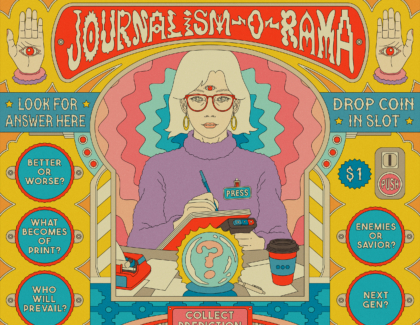Sign up for the daily CJR newsletter.
Two years ago, I launched the Texas Writers Byline Scan, an independent, annual demographic survey of writers and bylines at Texas-based quarterly, bimonthly, and monthly print magazines. In looking at writers’ racial identities, gender identities, and locations, I hoped to answer a deceptively complex question: Who tells stories for and about Texas and Texans?
Byline tracking has been a consistently inconsistent practice among advocacy groups, academics, writers, and (less frequently) news outlets themselves, who have turned the reporting lens around to examine newsroom and publication diversity—or more often, a lack thereof. The longest-running byline trackers are from the American Society of News Editors, now the News Leaders Association, which began looking at race and gender diversity in US newsrooms in 1978, briefly suspended their survey in 2019 due to low buy-in from news outlets, and picked back up again last year despite “crushing resistance” to the project from industry leaders. Others who have periodically surveyed demographics in newsrooms and bylines—usually gender, but sometimes also race, and rarely location—include the OpEd Project, the VIDA Count, and the Science Byline Counting Project, which looked at science beat bylines in 2016, inspired by Pulitzer winner Deborah Blum’s presentation on the dearth of women in science journalism to the 2013 National Association of Science Writers. Today, the Women’s Media Center tracks gender and race representation in print, broadcast, and online, in biannual-ish reports it began issuing in 2013.
Counting bylines is time-consuming and sensitive work. The fact that much of this work has historically been done by volunteers tasked with gathering data from sometimes hostile organizations likely explains byline tracking’s many fits and starts. The practice also has strong critics, who argue that numbers don’t show the full picture of whether or how newsrooms are safe and supportive places for journalists from marginalized backgrounds. But it’s hard to imagine how to pursue the deeper work of improving industry conditions for marginalized journalists without some kind of baseline.
“Being asked is often the first thing that gets some institutions to notice their awful lack of diversity, and the byline count is a metric of how sincere an institution’s commitment to diversity is, or at least how much has been invested in the effort,” said Gabriel Arana, who has covered newsroom and byline diversity for CJR and elsewhere, and who found himself on the receiving end of “being asked” when he took over as the Texas Observer’s editor in chief in 2022 following a public shake-up that included the voluntary exodus of staffers of color, including the magazine’s first Native editor in chief. The Observer is Texas’s only left-leaning print magazine, and nearly seventy years after the antiracist, progressive publication’s inception, its 2022 byline and writer demographics heavily favor white and male writers based in Austin. (I worked as a columnist and digital editor at the Observer in the mid-2010s and have freelanced for the magazine.)
The Texas Observer is hardly unique; a dozen of the fourteen publications surveyed in the 2022 Texas Writers Byline Scan published a majority of white writers. Some published white people almost exclusively: 93 percent of bylines in Austin Monthly in 2022 were attributed to white writers. In a state where white people no longer hold a racial majority—indeed, Hispanic Texans are now a larger population than white Texans—it seems a reasonable goal for Texas magazines to, as Texas Monthly editor in chief Dan Goodgame put it to me, “look more like Texas.” Goodgame said he welcomes “being held to account for that, even when the results are not what we wish they were.” And the results very much are not. Both Texas Monthly’s own byline data, tracked by an internal DEI committee, and the Texas Writers Byline Scan show the self-described “national magazine of Texas” backsliding on representation of nonwhite, nonmale, non-Austin-dwelling writers in its pages between 2021 and 2022.
In contrast, racial representation at Houstonia magazine shifted significantly from 2021—when 76 percent of bylines were attributed to white writers—to 2022, when 58 percent of bylines were attributed to writers of color (44 percent of whom were Black or African American), making Houstonia the only outright majority-of-color magazine in Texas. The Bend Magazine, which serves the Corpus Christi area, had the strongest representation of Hispanic or Latino/a/x writers, followed by San Antonio Magazine, Texas Highways, and the Texas Observer.
The gender story at Texas magazines seems to buck national newsroom trends, where men remain overrepresented. In Texas, women and non-cisgender writers are better represented in magazines compared with their makeup of the Texas population, together filing 61 percent of bylines in 2022. However, that overrepresentation drops off in prestige placements such as features, essays, and named cover teases; men writers’ names appear on the covers of Texas magazines twice as often as women writers’ names do. Fort Worth Magazine was a gender outlier, publishing 71 percent of bylines by men writers in 2022. Half of the magazines surveyed published no non-cisgender writers in 2022.
And Texas magazines didn’t only publish Texas writers; writers filing stories from New York and California in 2022 outnumbered writers from Galveston, El Paso, Bryan/College Station, Marathon and Marfa—combined. Writers in Austin and Dallas–Fort Worth filed the most bylines in 2022, while Texas writers living in rural geographies, especially the Texas Plains, Panhandle, West Texas, and the Rio Grande Valley, were notably underrepresented in magazines that ostensibly serve the entire state.
The idea of progress—how it is made, measured, and messaged—was very much on my mind when I began working on the Texas Writers Byline Scan in late 2021. I had the sense that, amid uprisings against racial injustice, escalating attacks on transgender people, and the aftermath of the #MeToo movement, it would be worthwhile to examine who is tasked with (and paid for) the responsibility of telling stories in and about the Lone Star State. Texas-based print magazines offered a scope that seemed manageable for a one-woman project (as opposed to trying to tackle newspapers or Web bylines), so I dived in, spending weeks reviewing magazines by hand and inviting writers to fill out a demographic survey.
Limiting my purview turned out to have bigger advantages than simply protecting my own capacity. I know that Texas magazine people read their colleagues and competition and gossip about one another, creating a natural conversational pipeline about byline and writer diversity even when magazines are publicly indifferent or hostile to my project (many are the former, a couple are the latter). Often, diversity efforts are derailed after initial attempts at progress don’t fix every problem immediately—the scale of the issues seems too big, the work needed to make corrections feels too intense, and the literal price of making long-term investments in DEI seems too high.
I surveyed eleven publications in 2021 and fourteen in 2022—just under five hundred writers penning over twenty-one hundred bylines each year—and while that’s a lot of work and a lot of people to demand do better, it doesn’t seem out of the bounds of reason that a dozen magazines could, over time, make real improvements. Engagement with the TWBS results has improved year over year. In 2021, two editors in chief spoke with me about their survey results; in 2022, seven editors in chief and/or assignment editors at eight magazines went on the record. Two Texas magazine decision-makers, the publisher of Southlake Style and the managing editor at Discover 361, expressly declined interview requests about the 2022 scan.
I’ve learned three key lessons from this work so far: First, it’s best to glean as much identity data as possible from writers themselves—not publications. Most magazines don’t track demographics anyway, but connecting directly with writers enables me to demonstrate that I am not an agent of a publication or of the person signing their checks, demanding they reveal personal information. Second, the invisibility of whiteness is a major challenge to this work. White people simply do not tend to explicitly identify ourselves as such. In the absence of a direct survey response (the TWBS survey has about a 75 percent response rate) or the rare express self-description, I am forced to make more guesses—informed guesses, but guesses nonetheless—about white racial identity than I had originally expected or wanted to do. And third, committing long-term is the only way to do this right. In just two years, the quality of my data has improved significantly.
The root causes of journalism’s homogeneity are many—they are systemic and institutional and interpersonal all at once. But byline counts, when conducted with a targeted scope, on behalf of writers, and consistently over time, can ensure that ignorance and insufficient evidence are not among them.
Correction: an earlier version of this story misstated the response rate to the TWBS survey.
Has America ever needed a media defender more than now? Help us by joining CJR today.







